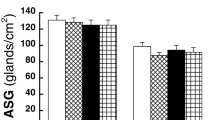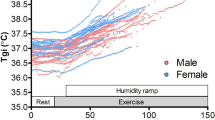Abstract
To examine the mechanisms underlying the age-related decrement in the ability to sweat, seven older (64–76 years) and seven younger (20–24 years) men participated in a 60-min sweating test. The test consisted of placing the subject's lower legs in a water bath at 42°C while sitting in a controlled environment of 35°C ambient temperature and 45% relative humidity. The rectal (T re) and skin temperatures, local sweating rates (m˙ sw: on the forehead, chest, back, forearm and thigh) and the frequency of sweat expulsion (f sw) were measured during the test. No group difference was observed in the mean body temperature (T¯ b) throughout the passive heating, although the older men had a higher T re and a lower mean skin temperature during the last half of the 60-min test. There were no group differences in the T¯ b threshold for sweating, although the time to the onset of sweating tended to be longer for the older men regardless of body site. The m˙ sw increased gradually for approximately 35 min after the start of heat exposure in the older men and for 30 min in the younger men and then reached a steady state. During the first half of the test, the older men had a significantly lower m˙ sw at all sites. During the last half of the test, only m˙ sw on the thigh was significantly lower in the older men than in the younger men. There was no group difference in the slope of f sw versus T¯ b (an indicator of the change in the central sudomotor response to thermal input). The slope of m˙ sw versus f sw (an indicator of the change in peripheral activity in response to central sudomotor changes) was significantly lower on the thigh in the older men, but there were no differences for the other sites. These results suggest that in older men the lower thigh m˙ sw observed during the last half of the heat test was possibly due to age-related modifications of peripheral mechanisms involving the sweat glands and surrounding tissues. It was not due to a change in the central drive to sudomotor function. Furthermore, the sluggish m˙ sw responses in the older men appear to have been related to age-related modifications of the sensitivity of thermoreceptors in various body regions to thermal stimuli. They may also involve lower sweat glands' sensitivity to cholinergic stimulus or sluggish vasodilatation, and do not reflect age-related changes in the central drive.
Similar content being viewed by others
Author information
Authors and Affiliations
Additional information
Accepted: 1 September 1998
Rights and permissions
About this article
Cite this article
Inoue, Y., Shibasaki, M., Ueda, H. et al. Mechanisms underlying the age-related decrement in the human sweating response. Eur J Appl Physiol 79, 121–126 (1999). https://doi.org/10.1007/s004210050485
Issue Date:
DOI: https://doi.org/10.1007/s004210050485




